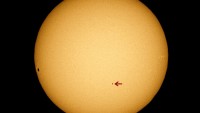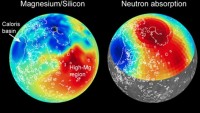First USGS Digital Topographic Map of Mercury Shows Entire Surface
| Arthur Dominic Villasanta | | May 09, 2016 10:44 PM EDT |
(Photo : USGS) New USGS digital map of Mercury
The U.S. Geological Survey (USGS) and partner organizations have released the first ever global topographic map of Mercury showing in high-resolution the first comprehensive view of the planet's entire surface. The digital map can be viewed here.
Like Us on Facebook
Data for the digital map was derived from the MESSENGER spacecraft that orbited Mercury from 2011 to 2015. It led to the production of the extremely detailed digital topographic map that illustrates elevation changes and landforms.
MESSENGER's cameras and instruments collected the extraordinary images during 4,104 orbits around Mercury. MESSENGER, which stands for MErcury Surface, Space ENvironment, GEochemistry, and Ranging, was the first spacecraft to orbit the planet.
The highly detailed map shows the planet's craters, volcanoes and tectonic landforms. To produce this map, scientists from USGS developed new and sophisticated software applications and procedures using the Integrated Software for Imagers and Spectrometers (ISIS), a digital image processing software package. ISIS can manipulate imagery collected by current and past NASA and International planetary missions traveling throughout the Solar System.
Using ISIS, over 100,000 spacecraft images and photos detailing Mercury's landforms and features were combined to create the new digital map.
"The creation of this map is a prime example of the utility and beauty that can come out of overcoming complex cartographic problems," said Lazlo Kestay, USGS Astrogeology Science Center Director.
"This highly aesthetic product literally provides a whole new dimension to the study of Mercury images, opening many new paths to understanding the surface, interior, and past of the closest planet to the sun."
"The wealth of these data, greatly enhanced by the extension of MESSENGER's primary one-year mission to more than four years, has already enabled and will continue to enable exciting scientific discoveries about Mercury for decades to come," said Susan Ensor, software engineer at The Johns Hopkins University Applied Physics Laboratory.
Partnering with USGS were Arizona State University, Carnegie Institute of Washington, The John Hopkins University Applied Physics Laboratory and NASA.
TagsMercury, U.S. Geological Survey, messenger, global topographic map of Mercury, NASA, Integrated Software for Imagers and Spectrometers
©2015 Chinatopix All rights reserved. Do not reproduce without permission
EDITOR'S PICKS
-

Did the Trump administration just announce plans for a trade war with ‘hostile’ China and Russia?
-

US Senate passes Taiwan travel bill slammed by China
-

As Yan Sihong’s family grieves, here are other Chinese students who went missing abroad. Some have never been found
-

Beijing blasts Western critics who ‘smear China’ with the term sharp power
-

China Envoy Seeks to Defuse Tensions With U.S. as a Trade War Brews
-

Singapore's Deputy PM Provides Bitcoin Vote of Confidence Amid China's Blanket Bans
-

China warns investors over risks in overseas virtual currency trading
-

Chinese government most trustworthy: survey
-

Kashima Antlers On Course For Back-To-Back Titles
MOST POPULAR
LATEST NEWS
Zhou Yongkang: China's Former Security Chief Sentenced to Life in Prison

China's former Chief of the Ministry of Public Security, Zhou Yongkang, has been given a life sentence after he was found guilty of abusing his office, bribery and deliberately ... Full Article
TRENDING STORY

China Pork Prices Expected to Stabilize As The Supplies Recover

Elephone P9000 Smartphone is now on Sale on Amazon India

There's a Big Chance Cliffhangers Won't Still Be Resolved When Grey's Anatomy Season 13 Returns

Supreme Court Ruled on Samsung vs Apple Dispute for Patent Infringement

Microsoft Surface Pro 5 Rumors and Release Date: What is the Latest?












